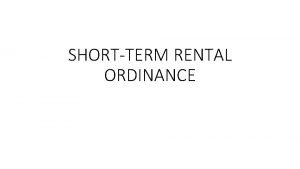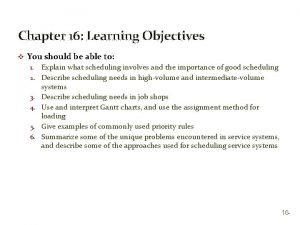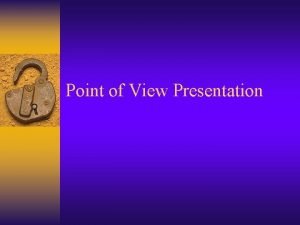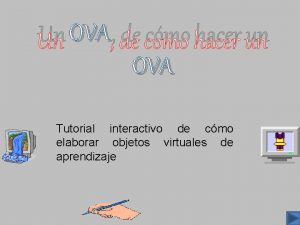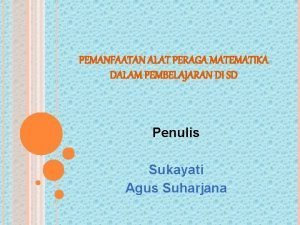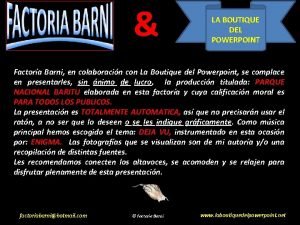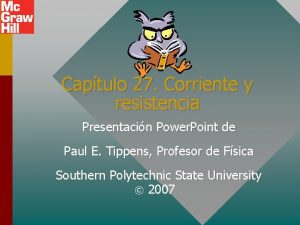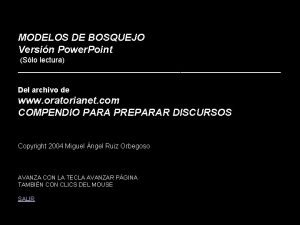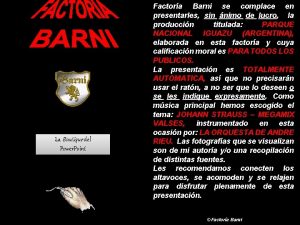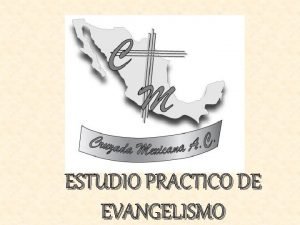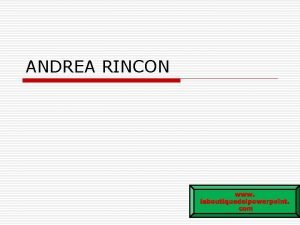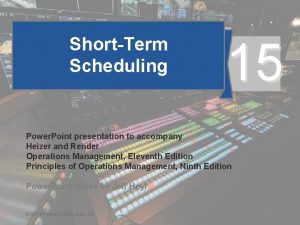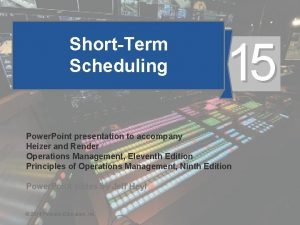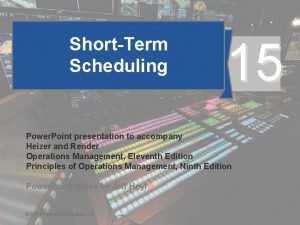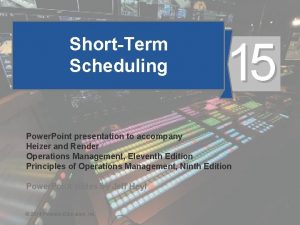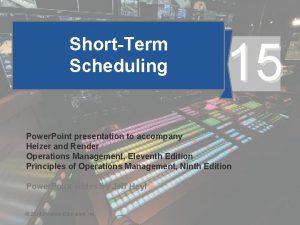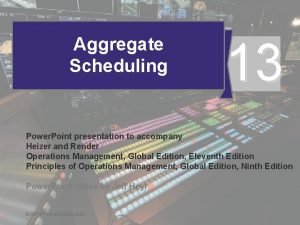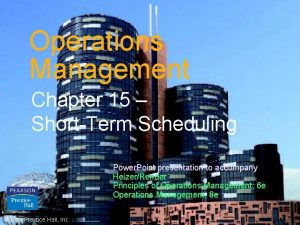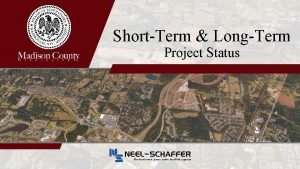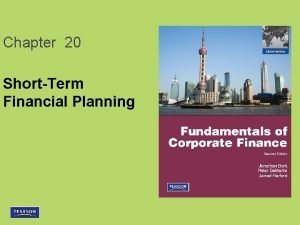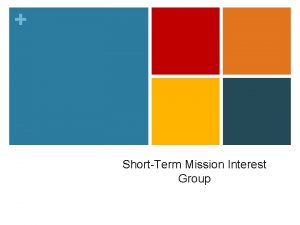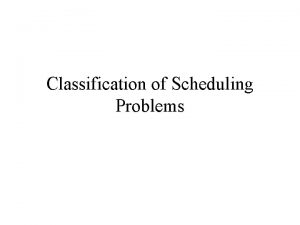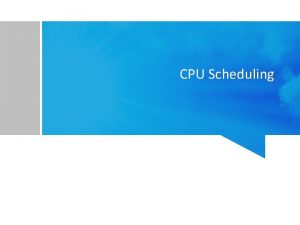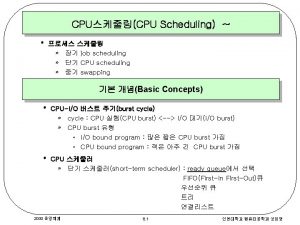ShortTerm Scheduling 15 Power Point presentation to accompany


































































- Slides: 66

Short-Term Scheduling 15 Power. Point presentation to accompany Heizer and Render Operations Management, Eleventh Edition Principles of Operations Management, Ninth Edition Power. Point slides by Jeff Heyl © 2014 Pearson Education, Inc. 15 - 1

Outline ► ► ► The Importance of Short-Term Scheduling Issues Scheduling Process-Focused Facilities © 2014 Pearson Education, Inc. 15 - 2

Outline - Continued ► ► Loading Jobs Scheduling Jobs Finite Capacity Scheduling (FCS) Scheduling Services © 2014 Pearson Education, Inc. 15 - 3

Short-Term Scheduling The objective of scheduling is to allocate and prioritize demand (generated by either forecasts or customer orders) to available facilities © 2014 Pearson Education, Inc. 15 - 4

Importance of Short-Term Scheduling ▶ Effective and efficient scheduling can be a competitive advantage ▶ Faster movement of goods through a facility means better use of assets and lower costs ▶ Additional capacity resulting from faster throughput improves customer service through faster delivery ▶ Good schedules result in more dependable deliveries © 2014 Pearson Education, Inc. 15 - 5

Scheduling Issues ▶ Scheduling deals with the timing of operations ▶ The task is the allocation and prioritization of demand ▶ Significant factors are 1. Forward or backward scheduling 2. Finite or infinite loading 3. The criteria for sequencing jobs © 2014 Pearson Education, Inc. 15 - 6

Scheduling Flow Figure 15. 1 © 2014 Pearson Education, Inc. 15 - 7

Forward and Backward Scheduling ▶ Forward scheduling starts as soon as the requirements are known ▶ Produces a feasible schedule though it may not meet due dates ▶ Frequently results in buildup of work-inprocess inventory Now © 2014 Pearson Education, Inc. Due Date 15 - 8

Forward and Backward Scheduling ▶ Backward scheduling begins with the due date and schedules the final operation first ▶ Schedule is produced by working backwards though the processes ▶ Resources may not be available to accomplish the Due schedule Now Date © 2014 Pearson Education, Inc. 15 - 9

Forward and Backward Scheduling ▶ Backward scheduling begins with the due date and schedules thesfinal operation first e r a e h c a ro e p d p a r a t ▶ Schedulethis produced by working e a s p e o l e n v e e t f y d t i O o c t backwards though the processes a d p e a n c i r b n e e m m e o co t w s et u b c f f d o n ▶ Resources amay anot s t n i s n r t o i s t n a t c co be available to e p x e accomplish the Due schedule Now Date © 2014 Pearson Education, Inc. 15 - 10

Finite and Infinite Loading ▶ Assigning jobs to work stations ▶ Finite loading assigns work up to the capacity of the work station ▶ All work gets done ▶ Due dates may be pushed out ▶ Infinite loading does not consider capacity ▶ All due dates are met ▶ Capacities may have to be adjusted © 2014 Pearson Education, Inc. 15 - 11

Scheduling Criteria 1. Minimize completion time 2. Maximize utilization of facilities 3. Minimize work-in-process (WIP) inventory 4. Minimize customer waiting time © 2014 Pearson Education, Inc. 15 - 12

Different Processes/ Different Approaches Different Processes Suggest Different Approaches to Scheduling Process-focused facilities (job shops) ► Scheduling to customer orders where changes in both volume and variety of jobs/clients/patients are frequent ► Schedules are often due-date focused, with loading refined by finite loading techniques ► Examples: foundries, machine shops, cabinet shops, print shops, many restaurants, and the fashion industry Repetitive facilities (assembly lines) ► Schedule module production and product assembly based on frequent forecasts ► Finite loading with a focus on generating a forward-looking schedule ► JIT techniques are used to schedule components that feed the assembly line ► Examples: assembly lines for washing machines at Whirlpool and automobiles at Ford. TABLE 15. 2 © 2014 Pearson Education, Inc. 15 - 13

Different Processes/ Different Approaches Different Processes Suggest Different Approaches to Scheduling Product-focused facilities (continuous) ► Schedule high volume finished products of limited variety to meet a reasonably stable demand within existing fixed capacity ► Finite loading with a focus on generating a forward-looking schedule that can meet known setup and run times for the limited range of products ► Examples: huge paper machines at International Paper, beer in a brewery at Anheuser-Busch, and potato chips at Frito-Lay TABLE 15. 2 © 2014 Pearson Education, Inc. 15 - 14

Focus for Different Process Strategies Process-focused (job shops) Repetitive facilities (assemble lines) Product-focused (continuous) Number of inputs Schedule orders Typical focus of the master production schedule Schedule modules Number of end items Schedule finished product Examples: Print shop Motorcycles Steel, Beer, Bread Machine shop Autos, TVs Lightbulbs Fine-dining restaurant Fast-food restaurant Paper © 2014 Pearson Education, Inc. 15 - 15

Scheduling Process. Focused Facilities ▶ High-variety, low volume ▶ Production differ considerably ▶ Schedule incoming orders without violating capacity constraints ▶ Scheduling can be complex © 2014 Pearson Education, Inc. 15 - 16

Loading Jobs ▶ Assign jobs so that costs, idle time, or completion time are minimized ▶ Two forms of loading ▶ Capacity oriented ▶ Assigning specific jobs to work centers © 2014 Pearson Education, Inc. 15 - 17

Input-Output Control ▶ Identifies overloading and underloading conditions ▶ Prompts managerial action to resolve scheduling problems ▶ Can be maintained using Con. WIP cards that control the scheduling of batches © 2014 Pearson Education, Inc. 15 - 18

Figure 15. 2 Input-Output Control Example Work Center DNC Milling (in standard hours) Week Ending 6/6 6/13 6/20 6/27 7/4 Planned Input 280 280 280 Actual Input 270 250 285 280 Cumulative Deviation – 10 – 40 – 35 Planned Output 320 320 Actual Output 270 270 Cumulative Deviation – 50 – 100 – 150 – 200 0 – 20 – 10 +5 Cumulative Change in Backlog © 2014 Pearson Education, Inc. 7/11 15 - 19

Figure 15. 2 Input-Output Control Example Work Center DNC Milling (in standard hours) Week Ending 6/6 6/13 6/20 6/27 7/4 Planned Input 280 280 280 Actual Input 270 250 285 280 – 10 – 40 – 35 320 320 Actual Output 270 270 Cumulative Deviation – 50 – 100 – 150 – 200 0 – 20 – 10 +5 Explanation: Cumulative Deviation 270 input, 270 output implies Planned Output 0 change Cumulative Change in Backlog © 2014 Pearson Education, Inc. 7/11 Explanation: 250 input, 270 output implies – 20 change 15 - 20

Input-Output Control Example Options available to operations personnel include: 1. Correcting performances 2. Increasing capacity 3. Increasing or reducing input to the work center © 2014 Pearson Education, Inc. 15 - 21

Gantt Charts ▶ Load chart shows the loading and idle times of departments, machines, or facilities ▶ Displays relative workloads over time ▶ Schedule chart monitors jobs in process ▶ All Gantt charts need to be updated frequently to account for changes © 2014 Pearson Education, Inc. 15 - 22

Gantt Load Chart Example Figure 15. 3 Day Work Center Metalworks Monday Tuesday Job 349 Job 408 Painting Processing © 2014 Pearson Education, Inc. Friday Job 350 Mechanical Electronics Wednesday Thursday Job 408 Job 349 Job 295 Unscheduled Job 408 Job 349 Center not available 15 - 23

Gantt Load Chart Example Work center: Numerical Machine Monday Tuesday Wednesday Thursday Friday 7: 00 AM 8: 00 AM 9: 00 AM Job 153 JOB 125 10: 00 AM 11: 00 AM Job 104 12: 00 PM Job 148 Job 135 1: 00 PM 2: 00 PM 3: 00 PM Job 138 Job 132 4: 00 PM © 2014 Pearson Education, Inc. © 2011 Pearson 15 - 24

Gantt Schedule Chart Example Figure 15. 4 Job Day 1 Day 2 Day 3 Day 4 Day 5 A B Day 6 Day 7 Day 8 Start of an activity End of an activity Scheduled activity time allowed Actual work progress Maintenance Nonproduction time C Point in time when chart is reviewed Now © 2014 Pearson Education, Inc. 15 - 25

Assignment Method ▶ A special class of linear programming models that assigns tasks or jobs to resources ▶ Objective is to minimize cost or time ▶ Only one job (or worker) is assigned to one machine (or project) © 2014 Pearson Education, Inc. 15 - 26

Assignment Method ▶ Build a table of costs or time associated with particular assignments TYPESETTER JOB A B C R-34 $11 $14 $ 6 S-66 $ 8 $10 $11 T-50 $ 9 $12 $ 7 © 2014 Pearson Education, Inc. 15 - 27

Assignment Problem © 2014 Pearson Education, Inc. © 2011 Pearson 15 - 28

Sequencing Jobs ▶ Specifies the order in which jobs should be performed at work centers ▶ Priority rules are used to dispatch or sequence jobs ▶ FCFS: First come, first served ▶ SPT: Shortest processing time ▶ EDD: Earliest due date ▶ LPT: Longest processing time © 2014 Pearson Education, Inc. 15 - 29

Sequencing Example Apply the four popular sequencing rules to these five jobs Job A B C D E © 2014 Pearson Education, Inc. Job Work (Processing) Time (Days) 6 2 8 3 9 Job Due Date (Days) 8 6 18 15 23 15 - 30

Sequencing Example FCFS: Sequence A-B-C-D-E Job Sequence Job Work (Processing) Time Flow Time Job Due Date Job Lateness A 6 6 8 0 B 2 8 6 2 C 8 16 18 0 D 3 19 15 4 E 9 28 23 5 28 77 © 2014 Pearson Education, Inc. 11 15 - 31

Sequencing Example FCFS: Sequence A-B-C-D-E Sum of total flow time Number of jobs Average completion time = = 77/5 = 15. 4 days Total job work time Utilization metric = Sum of total flow time = 28/77 = 36. 4% Sum of total flow time Average number of = = 77/28 = 2. 75 jobs in the system Total job work time Average job lateness = © 2014 Pearson Education, Inc. Total late days Number of jobs = 11/5 = 2. 2 days 15 - 32

Sequencing Example SPT: Sequence B-D-A-C-E Job Sequence Job Work (Processing) Time Flow Time Job Due Date Job Lateness B 2 2 6 0 D 3 5 15 0 A 6 11 8 3 C 8 19 18 1 E 9 28 23 5 28 65 © 2014 Pearson Education, Inc. 9 15 - 33

Sequencing Example SPT: Sequence B-D-A-C-E Average completion time = Sum of total flow time = 65/5 = 13 days Number of jobs Total job work time Utilization metric = Sum of total flow time = 28/65 = 43. 1% Average number of jobs in the system = Sum of total flow time = 65/28 = 2. 32 jobs Total job work time Average job lateness = © 2014 Pearson Education, Inc. Total late days Number of jobs = 9/5 = 1. 8 days 15 - 34

Sequencing Example EDD: Sequence B-A-D-C-E Job Sequence Job Work (Processing) Time Flow Time Job Due Date Job Lateness B 2 2 6 0 A 6 8 8 0 D 3 11 15 0 C 8 19 18 1 E 9 28 23 5 28 68 © 2014 Pearson Education, Inc. 6 15 - 35

Sequencing Example EDD: Sequence B-A-D-C-E Average completion time = Sum of total flow time = 68/5 = 13. 6 days Number of jobs Total job work time Utilization metric = Sum of total flow time = 28/68 = 41. 2% Average number of jobs in the system = Sum of total flow time = 68/28 = 2. 43 jobs Total job work time Total late days Average job lateness = Number of jobs = 6/5 = 1. 2 days © 2014 Pearson Education, Inc. 15 - 36

Sequencing Example LPT: Sequence E-C-A-D-B Job Sequence Job Work (Processing) Time Flow Time Job Due Date Job Lateness E 9 9 23 0 C 8 17 18 0 A 6 23 8 15 D 3 26 15 11 B 2 28 6 22 28 103 © 2014 Pearson Education, Inc. 48 15 - 37

Sequencing Example LPT: Sequence E-C-A-D-B Average completion time = Sum of total flow time = 103/5 = 20. 6 days Number of jobs Total job work time Utilization metric = Sum of total flow time = 28/103 = 27. 2% Sum of total flow time Average number of = = 103/28 = 3. 68 jobs in the system Total job work time Average job lateness = © 2014 Pearson Education, Inc. Total late days Number of jobs = 48/5 = 9. 6 days 15 - 38

Sequencing Example Summary of Rules Rule Average Completion Time (Days) Utilization Metric (%) Average Number of Jobs in System FCFS 15. 4 36. 4 2. 75 2. 2 SPT 13. 0 43. 1 2. 32 1. 8 EDD 13. 6 41. 2 2. 43 1. 2 LPT 20. 6 27. 2 3. 68 9. 6 © 2014 Pearson Education, Inc. Average Lateness (Days) 15 - 39

Comparison of Sequencing Rules ▶ No one sequencing rule excels on all criteria 1. SPT does well on minimizing flow time and number of jobs in the system ► But SPT moves long jobs to the end which may result in dissatisfied customers 2. FCFS does not do especially well (or poorly) on any criteria but is perceived as fair by customers 3. EDD minimizes maximum lateness © 2014 Pearson Education, Inc. 15 - 40

Critical Ratio (CR) ▶ An index number found by dividing the time remaining until the due date by the work time remaining on the job ▶ Jobs with low critical ratios are scheduled ahead of jobs with higher critical ratios ▶ Performs well on average job lateness criteria CR = Time remaining = Workdays remaining © 2014 Pearson Education, Inc. Due date – Today’s date Work (lead) time remaining 15 - 41

Critical Ratio Example Currently Day 25 JOB A B C DUE DATE 30 28 27 CRITICAL RATIO (30 - 25)/4 = 1. 25 (28 - 25)/5 =. 60 (27 - 25)/2 = 1. 00 WORKDAYS REMAINING 4 5 2 PRIORITY ORDER 3 1 2 With CR < 1, Job B is late. Job C is just on schedule and Job A has some slack time. © 2014 Pearson Education, Inc. 15 - 42

Critical Ratio Technique 1. Helps determine the status of specific jobs 2. Establishes relative priorities among jobs on a common basis 3. Adjusts priorities automatically for changes in both demand job progress 4. Dynamically tracks job progress © 2014 Pearson Education, Inc. 15 - 43

Sequencing N Jobs on Two Machines: Johnson’s Rule ▶ Works with two or more jobs that pass through the same two machines or work centers ▶ Minimizes total production time and idle time ▶ An N/2 problem, N number of jobs through 2 workstations © 2014 Pearson Education, Inc. 15 - 44

Johnson’s Rule 1. List all jobs and times for each work center 2. Choose the job with the shortest activity time. If that time is in the first work center, schedule the job first. If it is in the second work center, schedule the job last. 3. Once a job is scheduled, it is eliminated from the list 4. Repeat steps 2 and 3 working toward the center of the sequence © 2014 Pearson Education, Inc. 15 - 45

Johnson’s Rule Example JOB A B C D E WORK CENTER 1 (DRILL PRESS) 5 3 8 10 7 © 2014 Pearson Education, Inc. WORK CENTER 2 (LATHE) 2 6 4 7 12 15 - 46

Johnson’s Rule Example JOB A B C D E WORK CENTER 1 (DRILL PRESS) 5 3 8 10 7 © 2014 Pearson Education, Inc. WORK CENTER 2 (LATHE) 2 6 4 7 12 B E D C A 15 - 47

Johnson’s Rule Example JOB A B C D E WORK CENTER 1 (DRILL PRESS) 5 3 8 10 7 Time 0 3 WC 1 B 10 20 E 28 WORK CENTER 2 (LATHE) 2 6 4 7 12 B E D C A 33 D C A Idle WC 2 Job completed © 2014 Pearson Education, Inc. 15 - 48

Johnson’s Rule Example JOB A B C D E WORK CENTER 1 (DRILL PRESS) 5 3 8 10 7 Time 0 3 WC 1 B 10 28 B E D C A 33 E D C A Idle WC 2 Time 0 27 20 WORK CENTER 2 (LATHE) 2 6 4 7 12 B 1 3 29 E 5 31 7 33 B © 2014 Pearson Education, Inc. 9 35 10 11 D 12 13 E 17 C 19 A 21 22 23 D Job completed 25 C A 15 - 49

Limitations of Rule-Based Dispatching Systems 1. Scheduling is dynamic and rules need to be revised to adjust to changes 2. Rules do not look upstream or downstream 3. Rules do not look beyond due dates © 2014 Pearson Education, Inc. 15 - 50

Finite Capacity Scheduling ▶ Overcomes disadvantages of rule-based systems by providing an interactive, computer-based graphical system ▶ May include rules and expert systems or simulation to allow real-time response to system changes ▶ FCS allows the balancing of delivery needs and efficiency © 2014 Pearson Education, Inc. 15 - 51

Finite Capacity Scheduling Planning Data • Master schedule • BOM • Inventory Priority rules • Expert systems • Simulation models Interactive Finite Capacity Scheduling • Routing files • Work center information Tooling and other resources Setups and run time Figure 15. 5 © 2014 Pearson Education, Inc. 15 - 52

Finite Capacity Scheduling Figure 15. 6 © 2014 Pearson Education, Inc. 15 - 53

Scheduling Services Service systems differ from manufacturing MANUFACTURING SERVICES Schedules machines and materials Schedule staff Inventories used to smooth demand Seldom maintain inventories Machine-intensive and demand may be smooth Labor-intensive and demand may be variable Scheduling may be bound by union contracts Legal issues may constrain flexible scheduling Few social or behavioral issues Social and behavioral issues may be quite important © 2014 Pearson Education, Inc. 15 - 54

Scheduling Services ▶ Hospitals have complex scheduling system to handle complex processes and material requirements ▶ Banks use a cross-trained and flexible workforce and part-time workers ▶ Retail stores use scheduling optimization systems that track sales, transactions, and customer traffic to create work schedules in less time and with improved customer satisfaction © 2014 Pearson Education, Inc. 15 - 55

Scheduling Services ▶ Airlines must meet complex FAA and union regulations and often use linear programming to develop optimal schedules ▶ 24/7 operations like police/fire departments, emergency hot lines, and mail order businesses use flexible workers and variable schedules, often created using computerized systems © 2014 Pearson Education, Inc. 15 - 56

Scheduling Service Employees With Cyclical Scheduling ▶ Objective is to meet staffing requirements with the minimum number of workers ▶ Schedules need to be smooth and keep personnel happy ▶ Many techniques exist from simple algorithms to complex linear programming solutions © 2014 Pearson Education, Inc. 15 - 57

Cyclical Scheduling Example 1. Determine the staffing requirements 2. Identify two consecutive days with the lowest total requirements and assign these as days off 3. Make a new set of requirements subtracting the days worked by the first employee 4. Apply step 2 to the new row 5. Repeat steps 3 and 4 until all requirements have been met © 2014 Pearson Education, Inc. 15 - 58

Cyclical Scheduling Example DAY M T W T F S S Staff required 5 5 6 5 4 3 3 M T W T F S S 5 5 6 5 4 3 3 Employee 1 Capacity (Employees) Excess Capacity © 2014 Pearson Education, Inc. 15 - 59

Cyclical Scheduling Example DAY M T W T F S S Staff required 5 5 6 5 4 3 3 M T W T F S S Employee 1 5 5 6 5 4 3 3 Employee 2 4 4 5 4 3 3 3 Capacity (Employees) Excess Capacity © 2014 Pearson Education, Inc. 15 - 60

Cyclical Scheduling Example DAY M T W T F S S Staff required 5 5 6 5 4 3 3 M T W T F S S Employee 1 5 5 6 5 4 3 3 Employee 2 4 4 5 4 3 3 3 Employee 3 3 3 4 3 2 3 3 Capacity (Employees) Excess Capacity © 2014 Pearson Education, Inc. 15 - 61

Cyclical Scheduling Example DAY M T W T F S S Staff required 5 5 6 5 4 3 3 M T W T F S S Employee 1 5 5 6 5 4 3 3 Employee 2 4 4 5 4 3 3 3 Employee 3 3 3 4 3 2 3 3 Employee 4 2 2 3 2 Capacity (Employees) Excess Capacity © 2014 Pearson Education, Inc. 15 - 62

Cyclical Scheduling Example DAY M T W T F S S Staff required 5 5 6 5 4 3 3 M T W T F S S Employee 1 5 5 6 5 4 3 3 Employee 2 4 4 5 4 3 3 3 Employee 3 3 3 4 3 2 3 3 Employee 4 2 2 3 2 Employee 5 1 1 2 2 1 Capacity (Employees) Excess Capacity © 2014 Pearson Education, Inc. 15 - 63

Cyclical Scheduling Example DAY M T W T F S S Staff required 5 5 6 5 4 3 3 M T W T F S S Employee 1 5 5 6 5 4 3 3 Employee 2 4 4 5 4 3 3 3 Employee 3 3 3 4 3 2 3 3 Employee 4 2 2 3 2 Employee 5 1 1 2 2 1 Employee 6 1 1 1 0 Capacity (Employees) Excess Capacity © 2014 Pearson Education, Inc. 15 - 64

Cyclical Scheduling Example DAY M T W T F S S Staff required 5 5 6 5 4 3 3 M T W T F S S Employee 1 5 5 6 5 4 3 3 Employee 2 4 4 5 4 3 3 3 Employee 3 3 3 4 3 2 3 3 Employee 4 2 2 3 2 Employee 5 1 1 2 2 1 Employee 6 1 1 1 0 Employee 7 1 Capacity (Employees) 5 5 6 5 4 3 3 Excess Capacity 0 0 0 1 0 © 2014 Pearson Education, Inc. 15 - 65

All rights reserved. No part of this publication may be reproduced, stored in a retrieval system, or transmitted, in any form or by any means, electronic, mechanical, photocopying, recording, or otherwise, without the prior written permission of the publisher. Printed in the United States of America. © 2014 Pearson Education, Inc. 15 - 66
 Memory definition
Memory definition Shortterm housing
Shortterm housing Things that accompany salvation
Things that accompany salvation Accompany chapter 1
Accompany chapter 1 Apical group of axillary lymph nodes
Apical group of axillary lymph nodes Printers create objects such as prototypes and models.
Printers create objects such as prototypes and models. Job scheduling vs process scheduling
Job scheduling vs process scheduling Power point presentation topic in hindi
Power point presentation topic in hindi Power point presentation design west vancouver
Power point presentation design west vancouver Draw the power triangle
Draw the power triangle Power bi power point
Power bi power point Point point power
Point point power Scheduling in high-volume systems is known by what term?
Scheduling in high-volume systems is known by what term? Fetal lie
Fetal lie Fundal height transverse lie
Fundal height transverse lie Hand tools ppt
Hand tools ppt Point of view presentation
Point of view presentation The starting point in a presentation
The starting point in a presentation Solar power satellites and microwave power transmission
Solar power satellites and microwave power transmission Actual power
Actual power Flex power power supply
Flex power power supply Dispersive power of a grating is defined as
Dispersive power of a grating is defined as Power of a power property
Power of a power property General power rule
General power rule Power angle curve in power system stability
Power angle curve in power system stability Power absorbed or delivered
Power absorbed or delivered Evangelio del domingo en power point
Evangelio del domingo en power point Como hacer un ova
Como hacer un ova La boutique del power point rincones del mundo
La boutique del power point rincones del mundo Mario ančić
Mario ančić Tm pp
Tm pp Powerpoint sul riciclo
Powerpoint sul riciclo Blok dienes
Blok dienes Sabbath school powerpoint
Sabbath school powerpoint Barni
Barni La boutique del power point
La boutique del power point La boutique del power point
La boutique del power point La boutique del powerpointx
La boutique del powerpointx Gizi kuliner adalah
Gizi kuliner adalah Decreto 1330
Decreto 1330 Powerpoint
Powerpoint Autorretrato para un portafolio estudiantil
Autorretrato para un portafolio estudiantil Icon pada toolbar untuk format penomoran adalah…
Icon pada toolbar untuk format penomoran adalah… Como poner potencias en power point
Como poner potencias en power point Advantages of using power point
Advantages of using power point Ventajas y desventajas de powerpoint
Ventajas y desventajas de powerpoint Tesina power point
Tesina power point La boutique del power point x
La boutique del power point x Rambu-rambu penyusunan materi ajar adalah
Rambu-rambu penyusunan materi ajar adalah Power point fisica
Power point fisica Power point
Power point Concentrese en power point
Concentrese en power point Bosquejos en power point
Bosquejos en power point Civiltà egizia ppt
Civiltà egizia ppt La boutique del powerpoint pps
La boutique del powerpoint pps La boutique del powerpoint
La boutique del powerpoint La boutique del power point x
La boutique del power point x La boutique del power point
La boutique del power point La boutique del powerpoint
La boutique del powerpoint Apocalipsis 13
Apocalipsis 13 Poster naukowy
Poster naukowy Figurative language examples
Figurative language examples Tema evangelismo
Tema evangelismo Ventajas de power point
Ventajas de power point Power point
Power point Laboutiquedelpowerpoint
Laboutiquedelpowerpoint Power point 2002
Power point 2002

